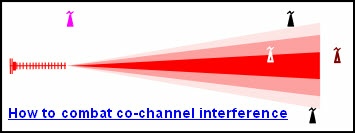Aerials
(also see FM / DAB aerials)
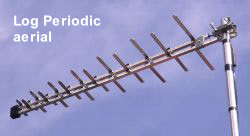
Subject list :
Aerial Polarisations (horizontal & vertical)
Signal Strength : “Am I in a strong signal area?”
Caravan / boat aerials
Types of Aerial incl :
- Quality, Size and Group
- Contract aerials
- Bacofoil aerials
VHF (FM & DAB) and UHF (TV) frequencies.
This is what we’re trying to receive through the aerial !
Note : From 2020 the C/D group frequencies will no longer be used for the transmission of the main digital MUXES, see 700MHz clearance,
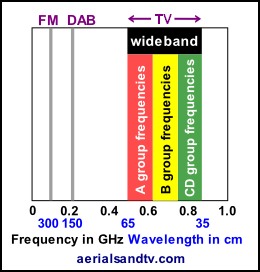
I’m an aerial man and I don’t particularly like satellites, but just out of interest the signals received at the dish (from a satellite) are of the order of 10 GHz, and the signal sent from the LNB to the receiver box is 1 to 2 GHz.
Aerial Polarisations
You may have wondered why some aerials are mounted (or polarised) horizontally and some vertically. To work efficiently aerials must be polarised in the same plane as the transmitter (TX) they are receiving from. All main TXs (e.g. Emley Moor) are horizontally polarised whereas repeaters (so called because they receive the signal from a main TX then rebroadcast it) are usually vertically polarised. The reason for this use of vertical and horizontal polarisation is to take advantage of the fall off in response (to a signal of the opposite polarity) to minimise co-channel interference between the various transmitters. This reduction in gain to opposite polarity signals is called "cross polar rejection".
Note : These are Contract aerials in the picture, and they are not recommended !
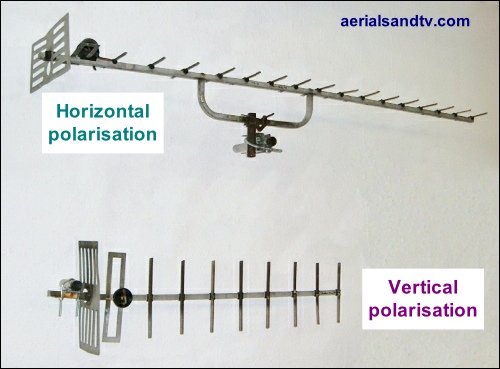
A good example of the use of differing polarities was Sheffield/Crosspool which is a repeater and is vertically polarised. Pre DSO it shared some of its frequencies with Belmont, but they both broadcast horizontally, thus the vertically polarised antennas on Sheffield were less likely to pick them up and cause co-channel. When we’ve tested aerials we have found the cross polar rejection to range from 11 to 35 dB (for individual frequencies), though it must be said that the results were somewhat inconsistent. "Grids" and 'high gain' Yagis were the best, Logs were in the middle and small Yagis were at the bottom. It was also apparent that aerials polarised vertically seemed to have a lower (i.e. worse) CPR than those mounted horizontally. However it should be stressed that CPR can be greatly influenced by nearby objects, e.g. the roof or the chimney, because RF waves can be cross polarised when they’re reflected, even off the ground ! This helps explain why our figures for cross polar rejection are lower than those of the manufacturers, because theirs are obtained in a lab where such cross polarisation does not occur, unlike in the real world..... We once went to a job where the aerial installation had fallen down and was now vertically polarised on Belmont (which is horizontal) but it still worked perfectly because the roof was cross polarising all the received signal ! When we deliberately cross polarised our shop aerial the (analogue, which is better to tell small differences in signal than digital) signal went from very good to awful, but if you are in a strong enough signal area even an incorrectly polarised aerial will still work reasonably well, despite losing 90% (or more) of the signal !
One last point to bear in mind is that vertically polarised aerials will be more susceptible to picking up off beam transmissions (the main cause of co-channel interference) because their polar diagrams aren’t as tight as for a horizontally polarised aerial.
The vast majority of TV aerials ever manufactured can be polarised horizontally or vertically.
High gain aerials
Note 1 : (VERY IMPORTANT) a small aerial with a built in amplifier is not, in any way, the equivalent of a “high gain” aerial !
NOTE 2 : we don’t recommend high gain wideband or T group aerials with built in LTE / 4G filters, for the reasons see this article.
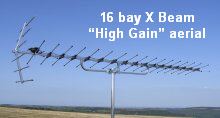
“High gain” is obviously a relative term but generally speaking an aerial with 18 elements (or more) is considered to be so. However element count is a bit of a contentious issue, so I’d take most manufacturers’ element counts with a large pinch of salt..... Basically (all other things being equal) the more elements an aerial has, and the longer the aerial is, the narrower the acceptance angle is and the more gain it will have. Unfortunately there is an inverse square law over the addition of elements to achieve more gain. Adding 2 elements to a dipole (to give a 3 element aerial) will give a relatively large increase in gain, but adding an extra 2 elements to an 18 element aerial will make very little difference. Once over 18 elements the law of diminishing returns really starts applying itself in a big way which is why we end up stocking XB16s, anything smaller wouldn’t give significantly more gain over a Yagi 18 or XB10.
As mentioned in the section on aerial groups, one of the biggest factors determining an aerials efficiency/gain (particularly at the bottom of the band) is if it is a grouped antenna or a wideband. In fact there is no such thing as a “high gain” wideband aerial for the A group frequencies. That said, grouped aerials may have more gain but I’ve never really seen the point of 10 element grouped antennas. After all the main reason for going grouped is to maximise signal (and/or minimise acceptance angle), so surely an 18 element should be fitted in these circumstances !
In terms of gain a Log36 (or Yagi18K) isn’t that far behind most 10 element grouped aerials, and they are widebands.
Whilst on the subject of "High Gain" aerials which aren’t actually high gain, XB5 aerials ( = X Beam and 5 bay) are not "high gain" and don’t let anyone tell you they are, see the proof, and after the 700MHz clearance they’ll be even less competitive in their gain ! Of course that is not to say they won’t work if you’re in a reasonable signal strength area (or just lucky), but, to be frank, when Log36s are available I don’t understand why anyone uses them [link].
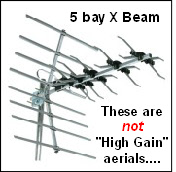
XB5 wideband aerials are certainly used quite often, but just because something is used often it doesn’t necessarily mean it’s any good. Flat roofs being a good example of the latter methinks. Flat roofs really are crap aren’t they ? I actually think they should be banned by the Building Regulations. Let’s face it, it really is basic isn’t it ? When I last checked, water had a pronounced tendency to flow downhill........
One other beneficial side effect of the narrow acceptance angle associated with high gain aerials is the reduction in the chances of multipath reception (this used to give ghosting with analogue pictures). That said, the most effective way to reduce multipath reception is to resite the aerial (possibly down the side of the house ? ) unfortunately this is not always possible, or guaranteed to be effective !
Sometimes a "High Gain "aerial can be used (even in a strong signal area, possibly with an attenuator) to minimise ghosting or co-channel interference from another transmitter, see Transmitter channel allocations. The theory is that you increase the signal from the required source more than that from the unwanted one. If the resultant level is too high the attenuator then knocks both signals back down but maintains the increased difference between them.
If the offending signal is coming from behind try using an aerial with a high rejection of signals from the rear, i.e. a Log Periodic or, particularly, a Grid.
The ultimate form of high gain aerial is the Phased Array though these are not generally installed just to increase gain. A phased array is two (or more) aerials linked together on to one downlead. The cables from each of the aerials to the combiner should be exactly the same length. The distance between the two antennas should be about one metre. Once the array is in situ experimentation should be undertaken to optimise the signal by varying the distance between the aerials and moving the antennas (front to back) relative to each other. Assuming the aerials are perfectly in phase then in theory it’s possible to obtain 3.5dB extra gain compared to a single aerial (which is a significant increase) but in practice losses in the combiner [usually a 2 way splitter “in reverse”] will generally reduce this figure to around 2dB or less. In fact using a simple splitter as a combiner will more or less attenuate all the signal you’ve just “gained”. However, any increase in the signal to noise ratio (that has been achieved by the phased array) would still be maintained.
It cannot be over emphasised how important it is for the two antennas to be perfectly in phase at the point where the combiner joins them together therefore a decent meter (not a £20 job.....) is essential when setting up a phased array. Any phase difference may very well give less gain, in fact if the two aerials were 180 degrees out of phase it would be theoretically possible to get no signal at all, not that this would ever actually happen in the real world !
It must be stressed that setting up a phased array can sometimes be difficult / time consuming and there are no guarantees how well it will work either, but, they can be very effective against multi path because they reduce the beam width and increase the front to back ratio, plus the reflected signals should be received slightly out of phase and therefore reduced.
For more information see Bill Wright’s articles on Stacking aerials and Eliminating ghosting (though in the digital age it would be multipath reception, which is the same thing really).
The transmitter in the picture is Birchover, a repeater in the Peak District. The bottom pair of aerials are 18 element Yagis in a phased array and are used to receive the signal from Stanton Moor. The latter is only just visible above the trees thus dictating the use of a pair of “high gain” Yagi receiving aerials.
Stanton Moor transmitter is itself a repeater and receives its signal off Waltham. The top array uses a couple of Log Periodics to retransmit the signal into Birchover village.
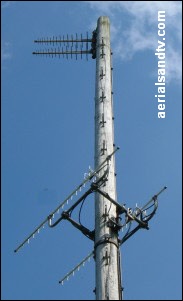
Types of aerial
Also see Yagis, Double Yagis, Tri Booms & X Beams (and Grids ! ), plus Log Periodic aerials
Most aerials are Yagis (though Log Periodics are becoming more popular) and there are three main variables in this type of antenna : Quality, Size and Group.
Contract Aerials
The (top) 18 element version is horizontally polarised whereas the (bottom) 10 element type is polarised vertically.
In Quality terms "Contract" aerials (the type with the plate type rear reflector) are generally at the bottom of the pile (apart from Bacofoil aerials, obviously
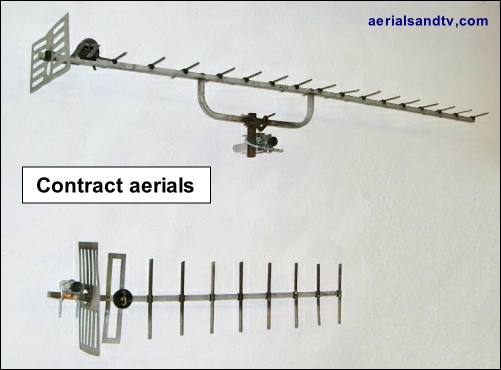
The elements on a Contract are of thinner/slimmer gauge alloy, in fact they have about 35% less metal than those on our Yagi18s. The Contract cradle (if fitted) is usually smaller and doesn’t have a tilting clamp, the latter allows the aerials elevation to be altered. The Contract aerial rear reflector is made of thin alloy plate which as well as being physically weak, has a relatively high wind loading for its small size. Most Contract aerials (particularly older ones) do not have baluns in the dipole. The performance of Contract aerials (in terms of gain wise and multipath, what was ghosting with analogue) can be very inconsistent. The best of them aren’t too bad, a good Contract 18 may only be about 1dB behind the best of the Yagi 18s (i.e. these ! ), but the worst of them are truly appalling. It’s not just the average gain figures (which can be up to 3dB down on a quality aerial of the same size) but they can have huge random dips in their already low gain curves, glitches of a further 4dB in some cases. Unfortunately it’s impossible to tell whether any particular Contract is a good un’ (relatively speaking of course ! ), or a bad un’, though if it’s got a balun in the dipole it’s a good sign. Historically most aerial installers have fitted contract aerials because they’re cheap, in fact in the 70s and 80s the price difference between Contracts and “quality” aerials was even bigger than it is today. Furthermore Contracts don’t take up much room on the van and they’re quick to assemble, remember “time is money”.
Without wishing to contradict myself, Contract aerial may be the Ladas of the aerial world, but at least they’re better made than Bacofoil aerials. DIYers who use Bacofoils have the excuse of ignorance (assuming they haven’t read this website ! ) but more and more "bottom end" aerial installers are starting to use them* rather than the Contract aerials they traditionally fitted, and they have no excuse at all because they know how flimsy they are. It’s an absolute disgrace. At least the errant installers who fit (or fitted) Contracts were using UK manufactured aerials, now they’re using Chinese made Bacofoils !
* Maybe they’re hoping to be called back when it gets blown apart by the wind. Or, more cynically, they think that they look more impressive (from the ground that is....) so they can charge more for the install, or possibly so they can (falsely) describe it as ”a digital aerial".
Is your aerial made of this ?

Unfortunately not all X Beam type aerials are created equal. Maybe it’s something to do with the basic design of X Beams (it may be costly to manufacture one which is sufficiently rugged) but the truth is many of them are rather flimsy to put it mildly. In fact a great many of these cheapo X Beams really are “Bacofoil” aerials, because their elements are so thin. This is particularly the case with most Philex / SLX / Labgear X beam type aerials (like in the adjoining picture), plus other economy types.
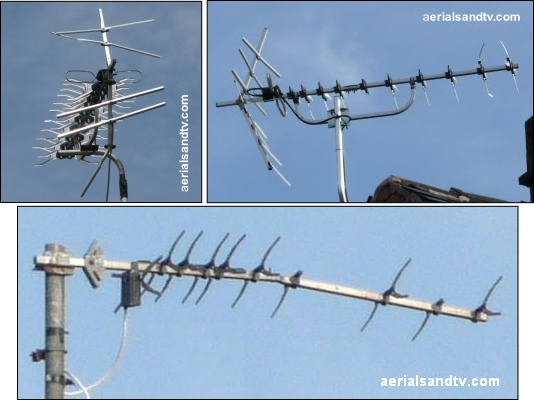
Having said all the above, even well made aerials aerials can be strengthened by junking any supplied wing nuts and fitting conventional nuts instead. These are far stronger and can also be tightened more effectively, do not over tighten them though ! If “Nylocs” are used (the type with the nylon insert to prevent them working loose) the fastening should never fail. To be honest I cannot understand why manufacturers use wing nuts at all, lets face it 99% of people fitting an aerial would have a spanner anyway and all professional installers have a decent ratchet spanner, so fitting a conventional nut would actually be easier to tighten up !
Note : nothing can compensate for an aerial which is manufactured in a flimsy manner to start off with. The easiest way to find out how well made your antenna really is ?
Try bending the elements, you may be shocked by how flimsy they are..........
Next we come to the Size of the antenna.
Most models of aerial are available in 2 or 3 sizes (e.g. 10 element or 18 element) to suit the particular installation. An appropriate analogy would be the same model of car being available with different engine sizes, although these days the number of elements is only a guide to an aerials gain, “element count” being as much to do with marketing as anything else. There is no point in fitting an aerial bigger than is actually required, though an installer (or an aerial supplier) trying to sell the job up may disagree with that ! Too much signal can be detrimental and there would also be an increase in wind loading.
Remember, most people do not need a big “high gain” aerial.
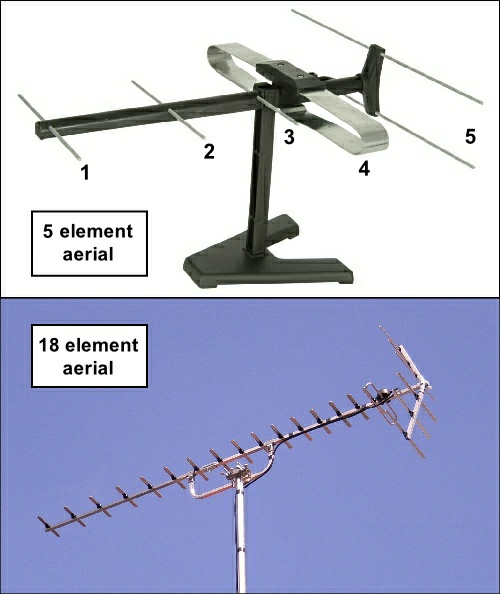
Finally we have the aerials Group. Historically most ranges of aerial have been available in all the major groups and wideband but there is now a trend by some manufacturers and suppliers to only deal in widebands. One reason includes the fact that more transmitters needed a wideband for the "digital switchover", but just as importantly (for them) is the fact that it’s much easier to manufacture just one aerial group. Even more significantly it’s far easier to sell just widebands rather than have to go into all the complexities of which transmitter the customer is on and which group would be a suitable choice etc. The downside, as we have seen, is that widebands have inferior performance because they are a design compromise, basically their "gain" (the amount of signal they pick up) is lower, particularly for the A group. Ironically in 2013 wideband aerials became technically obsolete, and will become even more so from 2022 when, indisputably, the K group will become the new "wideband" !
Note : widebands will continue to work, it's just that their extended frequency coverage (which is at the expense of gain) will be redundant.
Also see history of the aerial groups
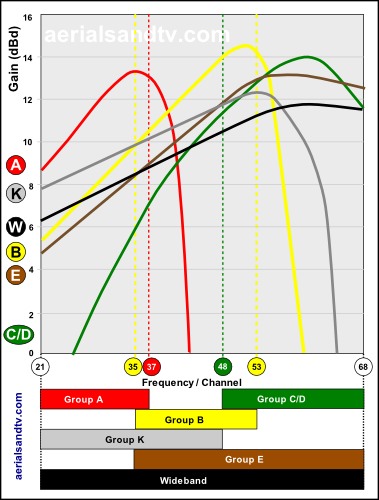
Also see Major Transmitters: Which Aerial To Use and Which Transmitter Am I On ?
See ATV’s Choice Of Aerials, And Why We Chose Them
For further reading on aerials/antennas see : Wikipedia and Astrosurf
OK, I accept that aerial is one of the more difficult words to spell, but here’s how NOT to do it :
aeriel, aereal, aireal, aireil, airial, arial, areil, ariel, areal & ariael.


